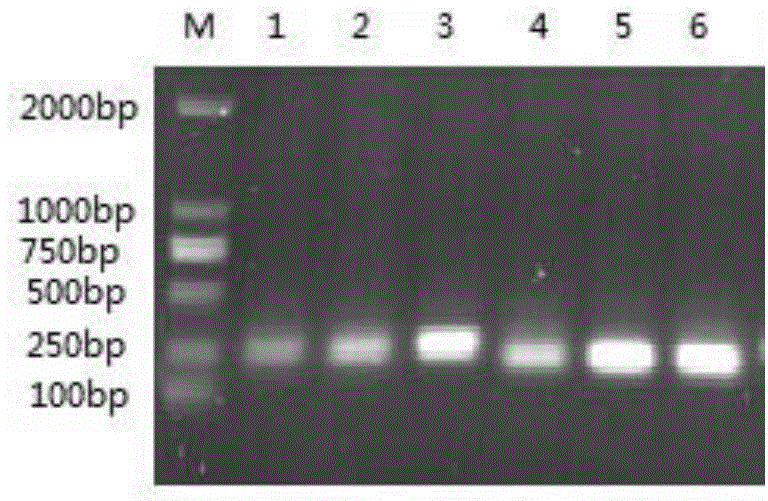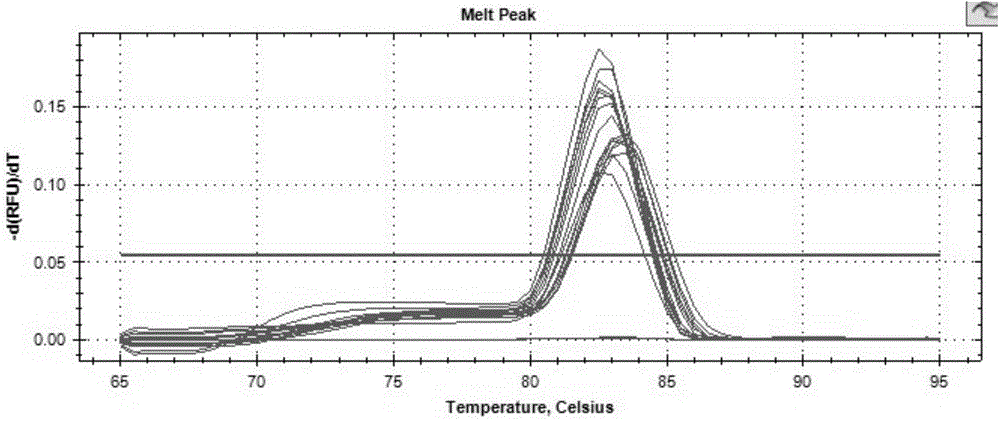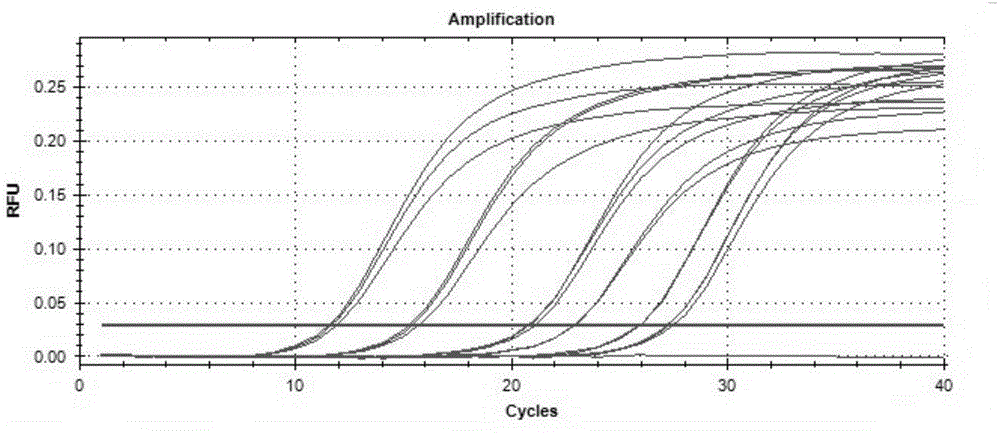Fluorogenic quantitative PCR kit for detecting swine transmissible gastroenteritis virus
A technology for infectious and gastroenteritis, applied in the field of fluorescent quantitative PCR kits, can solve the problems of long time consumption and low sensitivity, and achieve the effects of short time consumption, high sensitivity and rapid detection
- Summary
- Abstract
- Description
- Claims
- Application Information
AI Technical Summary
Problems solved by technology
Method used
Image
Examples
Embodiment 1
[0038] The preparation of embodiment 1 kit of the present invention
[0039] 1. Materials and instruments
[0040] The same experimental materials and instruments as mentioned above.
[0041] 2. Experimental method
[0042] 2.1 Fluorescence quantitative PCR primer design
[0043] According to the full sequence of the TGEV SC-H strain isolated in our laboratory, bioinformatics software was used to analyze the full sequence of TGEV, and the N gene of the TGEV SC-H strain was selected as the target sequence to design 3 pairs of fluorescent quantitative primers (Table 1). And sent to Shanghai Sangon Bioengineering Co., Ltd. for synthesis.
[0044] Table 1 Fluorescent quantitative RCR primers
[0045]
[0046] 2.2 Extraction of viral RNA and synthesis of cDNA
[0047] In the ultra-clean workbench, take out a small piece of TGEV attenuated vaccine, dilute it with 500 μL ultrapure water, and extract RNA. According to the instruction of TIANGEN Total RNA Extraction kit.
[0...
Embodiment 2
[0126] Embodiment 2 specificity experiment
[0127] 1. Test method
[0128] Separately extract porcine transmissible gastroenteritis virus (TGEV), porcine epidemic diarrhea virus (PEDV), porcine rotavirus (PoRV), Japanese encephalitis B (JEV), swine fever virus (CSFV), pig reproductive With the gene of respiratory syndrome virus (PRRSV), the second pair of primers (F2 and R2F: GCCAAGCATTACCCACAAC; R: TGGACGAGCATAGGCATTA) were used for fluorescent quantitative PCR, and DEPC-treated water was used as a blank control. To verify the specificity of the gene chip and kit of the present invention.
[0129] The fluorescent quantitative PCR reaction system is as follows, with a total volume of 20 μL:
[0130]
[0131] Reaction conditions: initial template denaturation at 95°C, 1min; denaturation at 95°C, 20sec; annealing at 58°C, 30sec; extension at 68°C, 30sec; 35 cycles.
[0132] 2. Results
[0133] Experimental results such as Figure 5 Shown, adopt the method of the present...
Embodiment 4
[0135] Embodiment 4 sensitivity test
[0136] 1. Test method
[0137] With concentration from 6.37×10 5 , 6.37×10 4 , 6.37×10 3 , 6.37×10 2 , 6.37×10 1 , 6.37×10 0 The copy / μL standard of porcine transmissible gastroenteritis virus (TGEV) plasmid was used as a template, and the second pair of primers (F2 and R2F: GCCAAGCATTACCCACAAC; R: TGGACGAGCATAGGCATTA) were used for fluorescent quantitative PCR to obtain the lowest template that can be detected copy number, while using DEPC-treated water as a blank control.
[0138] The fluorescent quantitative PCR reaction system is as follows, with a total volume of 20 μL:
[0139]
[0140] Reaction conditions: initial template denaturation at 95°C, 1min; denaturation at 95°C, 20sec; annealing at 58°C, 30sec; extension at 68°C, 30sec; 35 cycles.
[0141] 2. Results
[0142] The result is as Image 6 as shown,
[0143] With concentration from 6.37×10 5 , 6.37×10 4 , 6.37×10 3 , 6.37×10 2 , 6.37×10 1 , 6.37×10 0 The co...
PUM
 Login to View More
Login to View More Abstract
Description
Claims
Application Information
 Login to View More
Login to View More - R&D
- Intellectual Property
- Life Sciences
- Materials
- Tech Scout
- Unparalleled Data Quality
- Higher Quality Content
- 60% Fewer Hallucinations
Browse by: Latest US Patents, China's latest patents, Technical Efficacy Thesaurus, Application Domain, Technology Topic, Popular Technical Reports.
© 2025 PatSnap. All rights reserved.Legal|Privacy policy|Modern Slavery Act Transparency Statement|Sitemap|About US| Contact US: help@patsnap.com



